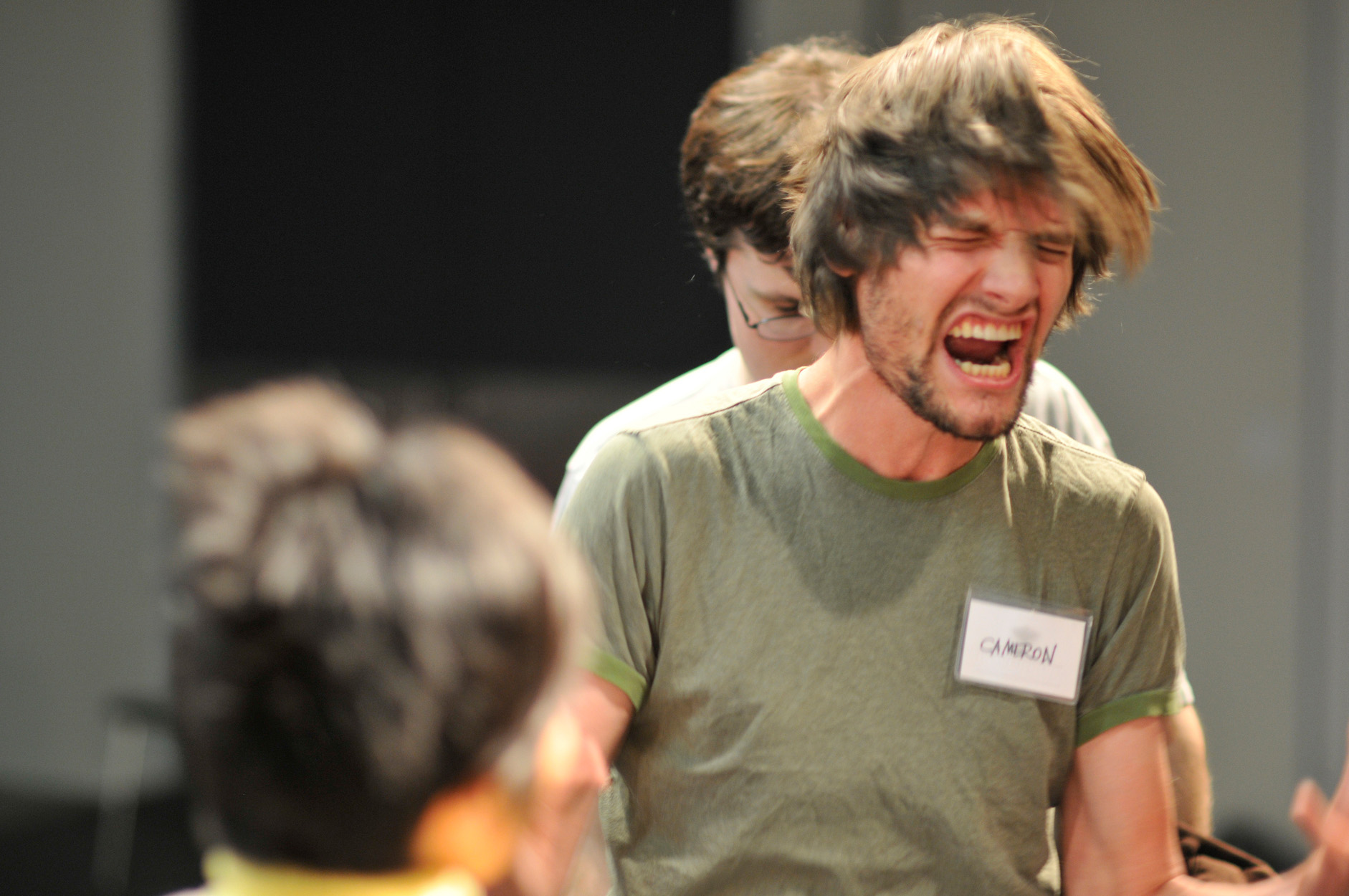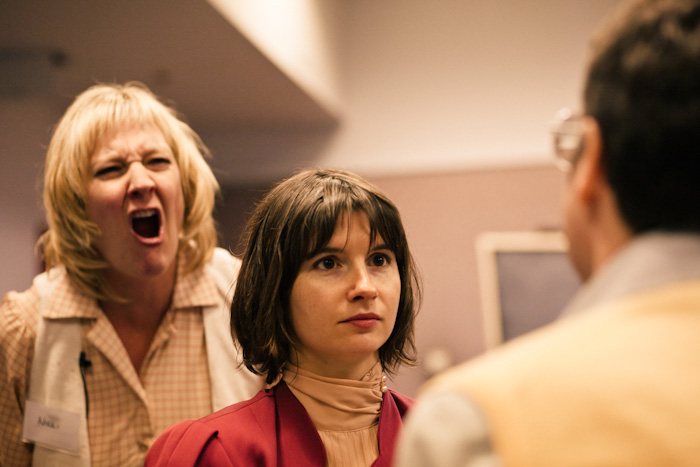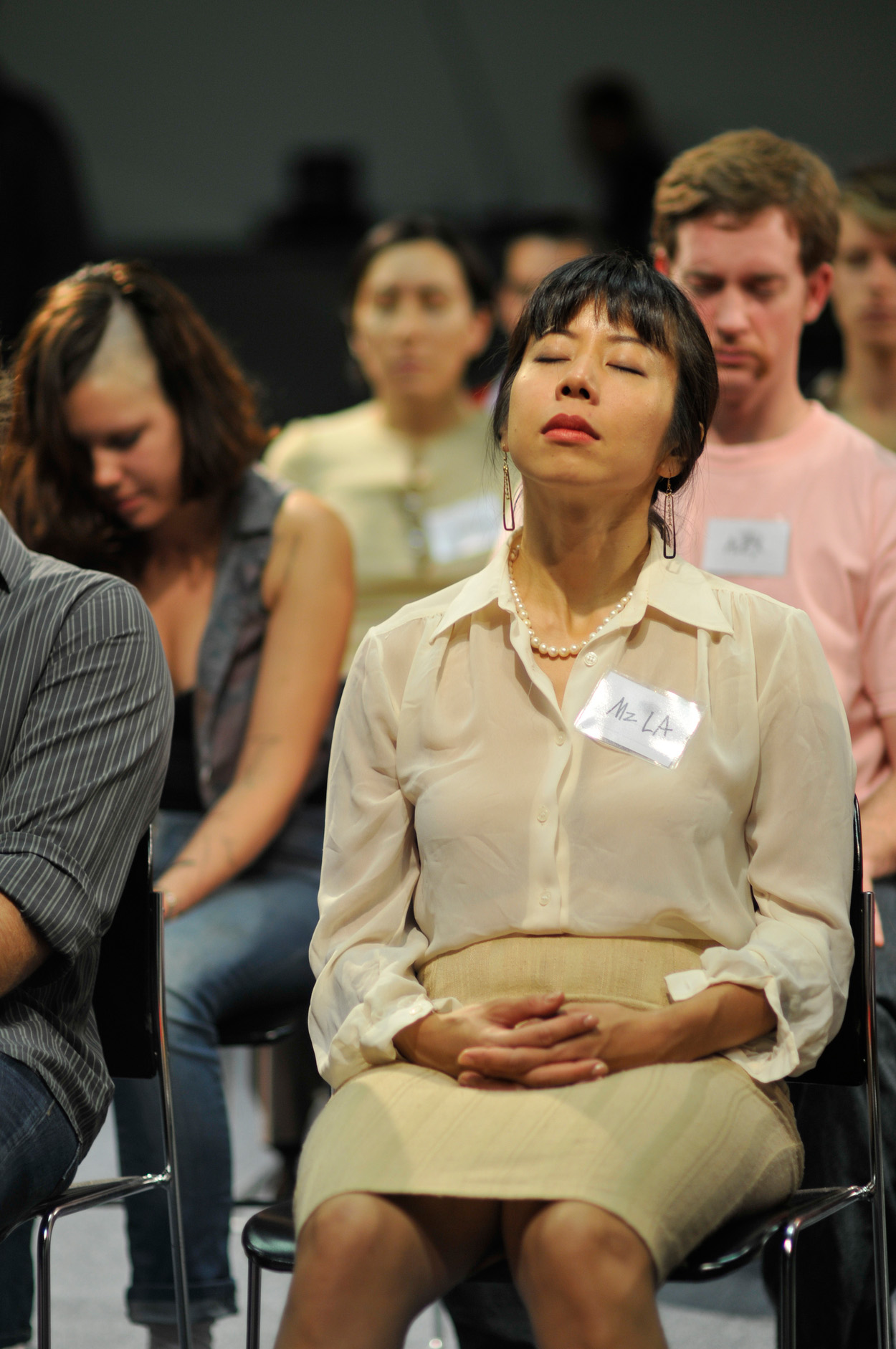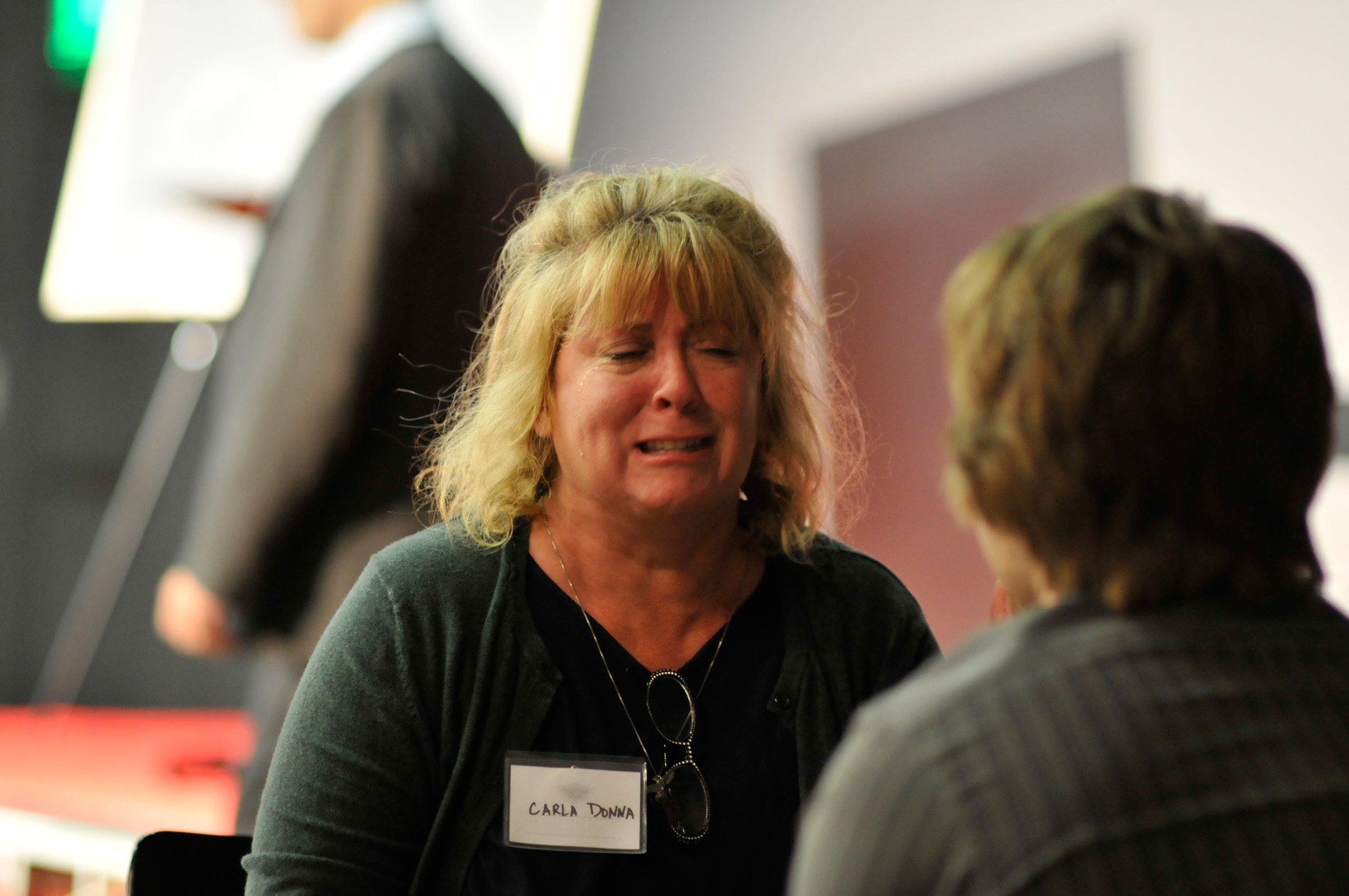Character Development: Brody Condon’s “Level5” and the Avant-LARP of Becoming Self
by Jennifer Krasinski

Participants in Brody Condon, Level5, 2010. Live action role playing performance at the Hammer Museum, September 4-5, 2010. Photos courtesy of the artist and the Hammer Museum, Los Angeles.
We tell ourselves stories in order to live. We live entirely, especially if we are writers, by the imposition of narrative line upon disparate images, by the “ideas” with which we have learned to freeze the shifting phantasmagoria which is our actual experience.
—Joan Didion, The White Album1
This part of the story begins on a spring morning in 1971, in a Mustang driving along a stretch of Northern California highway “somewhere between Corte Madera and the Golden Gate Bridge,” where a 35-year-old businessman—commuting to San Francisco to lead a sales meeting—had what he would later describe as “a transformation.” Like many of his generation, the man was a seeker of sorts who had spent the previous eight years studying and scrutinizing various therapies, spiritualisms and other kindred subjects ranging from Zen Buddhism and hypnosis to Gestalt therapy and Scientology. Over a decade earlier he had changed his name from Jack Rosenberg to the distinctly Germanic Werner Erhard, perhaps to distance himself from the indignities he felt as a child growing up in working-class Philadelphia. But in his new incarnation, he was no nobler a man; he lived as a wanderer, a philanderer, and a cheat. In generic terms, what he was searching for was enlightenment and the relief that would come from a deeper understanding of himself, but what he claimed to have discovered that day was, in fact, Self itself. “I didn’t just experience Self; I became Self,” he would recall to his biographer. “I was no longer the one who had all those experiences I had as a child. I was not identified by my ‘false identity’ any more than by my ‘true identity.’ All identities were false… I found enlightenment, truth, and true self all at once.”2It was also the moment when Erhard divined that his true vocation—his responsibility to his newfound peace—was to share his transformation with others.
In October of that same year, at a hotel in San Francisco, Werner Erhard conducted the first Erhard Seminars Training weekend (or est, written always in lowercase). Over the course of two days, he instructed attendees how to expand and transform their consciousness through a process of self-actualization of his devising, so that they too might experience a revelation similar to his own. In his own words:
The real point to the est training was to go down through layer after layer after layer after layer until you got to the last layer and peeled it off where the recognition was that it’s really all meaningless and empty. Now, that’s Existentialism’s end point. est went a step further in that people began to recognize that it was not only meaningless and empty, but that it was empty and meaningless that it was empty and meaningless! And in that, there’s an enormous freedom. All the constrictions, all of the rules you’ve placed on yourself are gone. And what you’re left with is nothing. And nothing is an extraordinarily powerful place to stand, because it is only from nothing that you can create. And from this nothing, people were able to invent a life, and allowing them to create themselves … invent themselves.3
The opportunity to master the tools of self-actualization—of self-invention—seemed to strike a deep and resonant chord within the baby boomers. At the end of 1971, est counted six hundred participants.4In 1978, the program could boast 178,000 attendees in that year alone. And at the price of $300 per seminar—the equivalent in 2010 to a little over $1,000—Erhard could be considered one of the founding captains of the self-help industry, and est one of the strongest and most intoxicating forces to shape and define the men and women of the Me Generation.5
Why Erhard’s generation may have felt their lives were inauthentic or unreal—why they were propelled with such force (and at such expense) into self-examination—is a story that has been written in innumerable ways: as the popular fallout of Freudian psychology as it moved and morphed American media and culture; as a result of their oppressive upbringings by the Greatest Generation; because of the rise of advertising and corporate culture as it constructed and projected ideal lives on now-pervasive television sets; gnawed by the insatiable appetites of a market economy that masked prosperity as patriotism, and greed as freedom; disappointed by the revolutions that failed to produce the desired utopias; shamed by the inability to stop—or to win—an unjust war in Vietnam. It is not far-fetched to think of Erhard as a masterful author who not only discovered the story his generation wanted to be told, but so perfectly constructed the story—so finely tuned his instrument—that it could echo the particular needs and desires of anyone who paid to listen.
And who still pays to listen. After closing est in 1984, Erhard sold his intellectual property rights to what is now known as Landmark Education, which claims 1.2 million participants worldwide and a revenue of approximately $77 million in 2009.6
Sifting through the artifacts and fictions of the baby boomers doesn’t require deep-dirt excavation; they are a generation that has preferred to pay their legacy forward rather than leave it behind, and those of us who belong to the generations that succeed them already find ourselves negotiating the inherited weight of their heaviest fabrications. Part of this heritage are the grand narratives of Self, plotted along the fine lines between empowerment and entitlement, actualization and aggrandizement, kinked by genres such as reality television, and distended by the transfusion of social networking into what has emerged as the Scripted Self—one penned by our own hands (posts, blogs, tweets), as well as handed to us (these formats/outlets being designed and programmed by others). We may tell ourselves stories in order to live, but an audience is required to complete the lifeline, and the stories aren’t wholly ours to begin with. Add to This Very Moment of the Self the harassment of the archive—the evaporating context and collapsing chronologies of a culture that furiously remakes and reinvents itself and its products—and what we begin to spin are stories of stories about stories. How then can we trace a history—understand what has come before us—when its presence is so closely felt?

Participants in Brody Condon, Level5, 2010. Live action role playing performance at the Hammer Museum, September 4-5, 2010. Photos courtesy of the artist and the Hammer Museum, Los Angeles.
Brody Condon can’t recall exactly when he first heard the story of Werner Erhard and est, but he thinks it may have been sometime in the early 2000s, when he was a graduate art student at the University of California at San Diego. “I was making the lamest performances within a visual art context that you can imagine,” he tells me, laughing and shaking his head. “It was a lot of naked people flailing around on the floor, screaming about some kind of trauma.” His eyes soften as he laughs even harder, and clarifies that by “naked people,” he meant himself. Condon speaks with candor about the childhood traumas that propelled his earliest forays into art making, and tells me that it was filmmaker J. P. Gorin—then his professor—who saw these early performances and suggested that he watch Adam Curtis’s documentary Century of the Self (2002). Weeks after my conversation with Condon, I watched the film, which tracks the dissemination of Freudian psychoanalysis throughout American popular culture via Madison Avenue, as well as the evolution of the still-booming self-help industry. Only then did I understand that what Gorin had done for the young artist was to give his subject matter—his investigations, his trauma—historical and political context.
Growing up between Florida and Missouri, Condon was the son of a Vietnam veteran who, by the 1980s, was trafficking in narcotics. His mother and stepfather moved to a farm in the Midwest in search of a pastoral, idyllic existence, but when they couldn’t make ends meet, they too turned to trafficking, and eventually became drug addicts. Condon survived the itinerant stresses and threats of his upbringing as many children have—by retreating into the escapist fictions of video games and tabletop role play such as Dungeons and Dragons.7 In his teens, he was introduced to the Society for Creative Anachronism —a group dedicated to reenacting medieval cultures and traditions, which later led him to discover the world of live action role play (or LARP).8While traditional reenactments prioritize exactitude (of costume, of recreation), LARPing distinguishes itself by focusing on a deeper investigation of the world in which the game is played. As Condon explains, “It’s a great set of tools to allow you to go through a lot of life situations that you wouldn’t have access to otherwise.”
Condon has come to think of LARPs as weekend-long social experiments—opportunities to explore alternative cultural situations and/or political structures—and understands the games as abridged versions of the communes his parents and their generation tried to establish and failed. “They believed too much,” he says of the baby boomers’ inability to understand the true potential of the communal experience. “I’m not sure which one is more radical—real or temporary communes—but I know this one has more potential at least. You can immerse yourself within a temporary commune, but you don’t have to believe in it. The other ones are limited by reality in a way.”
When Condon decided last year that he wanted to investigate Erhard Seminars Training and other large group awareness trainings as the subject of a performance, he chose to build the piece using the tools and game mechanics developed by the LARP community. In his own words:
With a [game] structure in place to reenact a self-actualization seminar, I realized that it might be more interesting—or possibly more critical—to have the separation between this immersion and the seminar structure so that you could look at the thing critically. And it just seemed more twisted in a way—completely ridiculous—to go through a seminar that’s all about losing your games—getting to the core of your being, shedding the layers of self—via an artificial layer of self, via character.
Therefore, rather than reenactment or traditional theatrical production, Condon’s piece would be a participatory performance in which players would be invited to create a character, and then take that character through the process of self-actualization. Within this hall of mirrors—one which would invariably reflect and refract the selves of both character and player—Condon hoped that he and the participants would not only arrive at a more thorough understanding (i.e., an experiential knowledge) of what a self-actualization weekend was—how it worked and what it did to the people of his parents’ generation—but also gain some kind of insight into the value and function of self-created fictions.
Condon titled the piece Level5, and its performance took place the first weekend of September at the Hammer Museum in Los Angeles.
“Many people ask what LARP is and how to define it,” Bjarke Pedersen tells me, “and I always say it’s a medium like cinema. You can make a very entertaining movie, or you can make a sociopolitical movie, or movies that are more radical. You can make a shitty movie, and you can make a shitty LARP. And you can also make a profound thing as well.” Pedersen and Tobias Wrigstad are Scandinavian game designers and highly experienced LARPers (Danish and Swedish, respectively) who were hired by Condon to write and develop the mechanics (in layman’s simplest terms: the rules) for Level5. Although Condon had done extensive research on his subject, any documentation that would provide the exact specs of the seminars—descriptions of the exercises or the leaders’ “scripts,” for example—is difficult to come by. In the case of est, much of the existing literature is pure propaganda for the program, and the companies that now own the rights to Erhard’s teachings and techniques are notoriously litigious. The absence of hard fact led Condon, Pedersen and Wrigstad to devise a semi-fictionalized version of a large group awareness training seminar based on the information they were able to access. However, one of their greatest challenges in the development of game mechanics for Level5 was to devise as many opportunities as possible for the players to interact with one another (better for the game) without disrupting the experience of the seminar’s inward journey (better for the player).

Participants in Brody Condon, Level5, 2010. Live action role playing performance at the Hammer Museum, September 4-5, 2010. Photos courtesy of the artist and the Hammer Museum, Los Angeles.
Pedersen and Wrigstad led a mandatory character-development workshop before the weekend, in which they explained the rules of LARPing—and the particular mechanics of Level5. Per these rules, I was told that if I as a writer wanted to observe, I had to do so “in game,” because audiences are not allowed inside the playing space. Condon offered me a kind of all-access pass to the weekend in the role of a Volunteer, someone who facilitates and assists the activities rather than participates. To preserve and respect the experience for the other participants, I had to attend in character and obey the mechanics of game play—namely, to never to break character and, when possible, to keep the game going and make it better and more interesting for everyone involved.
The participants themselves were a diverse group who varied in age and interests. A few of them had previous LARPing experience, though most were novices. The only official performers within Level5 played the seminar leaders; the rest were there without the comfort or assurance of scripts. Some were actors or artists interested in this particular strain of participatory performance, while others were curious to learn more about the history and methodologies of self-actualization programs. We were instructed that we must respect the physical limitations of both the space and the players, as well as play inside the parameters of the world’s logic. The designers devised certain meta-techniques for the players’ use, among which were the doling out of logbooks in which participants were to reflect and write both as their characters and as themselves; in addition there was a Grand Stand inside the museum’s seminar room, where one could take oneself out of game, yet remain in the space. (Caveat: the Grand Stand was invisible to those players still “in game” and therefore cannot affect the game itself). Although Pedersen and Wrigstad intended these safe spaces to provide a sense of comfort to the players, they could not provide enough assurance for all. Some participants came to the first meeting but did not return for the weekend, one admitting that she was too “freaked out” by the entire proposition to go through with it.
The “freak-out factor” was understandable and was by design, to some degree. That Condon designed a game in which the players play characters who have chosen to go away for a weekend in order to self-actualize—in character—built a kind of never-ending hall of mirrors into which one could easily get lost. Between core self, self, created-self, and the character and its core and created self—there were many layers to keep track of, to play off, to discover. For me, the weekend quickly became a blur of in-game dramas and eavesdropping on out-of-game conversations between Condon, Pedersen, Wrigstad and the rest of the volunteers. Within the game, I began to notice certain behaviors: some players who had freely signed up had chosen to play characters who did not want to participate, who were skeptical of the seminar and its intentions, and who seemed to want to trump the leaders. Others dove deeply into the damage they were trying to heal—people screamed, cried, badgered, comforted and consoled. I could not help but wonder if the players were aware of the cameramen who were recording their actions and broadcasting the scenes as a live-edit feed to the museum’s theater. I also wondered if knowing that this would all eventually be edited down to a video piece changed the dynamic of the role play, heightening the need for attention in some and shutting down others who tended toward self-consciousness.9

Participants in Brody Condon, Level5, 2010. Live action role playing performance at the Hammer Museum, September 4-5, 2010. Photos courtesy of the artist and the Hammer Museum, Los Angeles.
Pedersen and Wrigstad represent two very different schools of LARPing, and when I sat down to speak with them after the Level5 weekend, they both admitted that under normal circumstances they would never work together, so vastly divergent are their interests and techniques. “Essentially, Bjarke likes having the uninterrupted flow of being the character,” Wrigstad explained, “whereas for me, I’m interested in where the game starts and stops, where reality starts and stops. I like the breaks, and that’s kind of where it’s the most interesting to me really. Everything else is for the breaks.” If Wrigstad usually structures his games like a film or a video game—incorporating flashbacks, jumps in time, and replays—Pedersen, believes that LARPs should be played in a kind of “real-time” style—allowing for boredom, inaction, and organic moments inside the game for players to pause and reflect. It comes as no surprise then that Wrigstad’s LARPs typically last only a few hours, while Pedersen writes games that may run for a few days at a time.
What is also interesting to note is how vastly different the subjects of the LARPs are from what one might expect, and when I mentioned this, I was told that in Scandinavia, the LARP community has evolved past the stereotypical swashbucklers-and-swords kind of play to include what could be described as stories that are—at their core—social experiments, investigations into the structures and motivations of human behavior. For example, in 2004, Pedersen participated in a LARP for seventy players titled Mellan Himmel Och Hav (Between Heaven and Sea) that sought to deconstruct gender roles and investigate how narratives can be built without incorporating conflict. Wrigstad briefly described a five-hour game that he designed around a one-hour bus ride, which sounds as though it possessed some of the strange and beautiful mundanity of a work of Absurdist theater. However, what both game designers share very passionately is the belief that a LARP—no matter how it is written or played—is a meta-event that allows players to explore via character situations, problems, or personalities that they would not be ready—or be given the chance—to perform in the real world. “Normally when we go through life,” Pedersen clarifies, “we go through it in a very unconscious way. But here you are constantly probing the aspects of what you can do.” Therefore, what a LARP provides is a time and space—a theater in which the player and the audience are one—where action and reflection can occur simultaneously, and where the products of reflection rather than strategy—understanding and insight rather than “winning”—are the ultimate goals.
What surprised me most about Level5 was the predictability—the finite structures—not of the game itself, but of the narratives people use to construct their roles. During one particularly emotive exercise, the players were paired up and told to sit across from each other. One person was then instructed to say over and over again, “I am your mother” or “I am your father” while the other was instructed to speak openly and frankly about their feelings toward the “parent.” Walking around the room, I felt as though I could set my watch to the traumas people were working through—abandonment, refusal, control, smothering, bullying, lying, addiction, absence. What I cannot tell—what remained unclear—was whether these are stories we tell ourselves, or whether in fact these stories—so well-worn and familiar as to now provide some kind of perverse comfort—now tell us. Are these common fictions cultural prescriptions of a kind—heard over and over again, reenacted, remastered—and, if so, I find myself back in a hall of mirrors I was hoping would disappear, one that echoes the voice of Werner Erhard: “People spend so much of their life being bedeviled by their past and being locked into their past, and being limited by their past. And there’s an enormous freedom from that: letting people create themselves.”10“You’re playing roles every day,” I remember Condon telling me when I asked him about the fusion of game and reality. “Why not play one that you’ve created?”

Participants in Brody Condon, Level5, 2010. Live action role playing performance at the Hammer Museum, September 4-5, 2010. Photos courtesy of the artist and the Hammer Museum, Los Angeles.